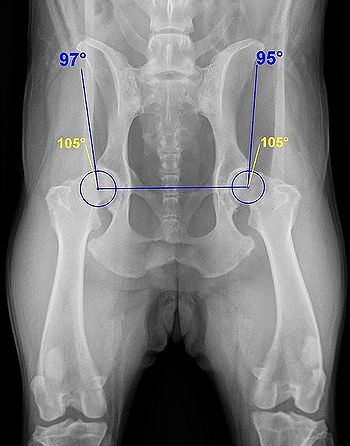
Dog PennHip Testing
Veterinarian Reviewed on June 17, 2012 by Dr. Janice Huntingford
Dog PennHip Testing
Introduction
Dog Hip Dysplasia was thought to be a rare condition when it was first described in the 1930s. It is known today as the most common inherited joint problem of large dog breeds. Regardless of the immense research undertaken over previous years along with the combined effort of the Orthopedic Foundation for Animals and responsible dog breeders, it is impossible to eliminate hip dysplasia from such breeds as Akita, Labrador Retriever, Golden Retriever, German Shepherd Dog and Rottweiler’s.
The diagnosis of Canine Hip Dysplasia is based on the breed, history, physical examination findings, and an x-ray of the pelvis. The x-ray is taken when the dog is in a laying down position on his back with legs fully extended and the knees inwardly rotated. The results of the x-ray are then evaluated for the general appearance of the hip joints along with any signs of degenerative joint disease (DJD).
The same style of x-ray has been used for the last 30 years in order to grade hips as having a conformation of excellence, good, or fair, and to attempt to predict which dogs are less likely to develop CHD. Breeders hoped that selecting the best dogs to breed and removing others from the breeding program would eliminate hip dysplasia, but there still remains a 20% to 25% chance of producing a puppy with CHD. It is clear that a better diagnostic method is required.
A new test
Dr. Gail Smith, an orthopedic surgeon at the University of Pennsylvania School of Veterinary Medicine, began researching the early diagnosis of CHD in 1983. Due to this research and work, the PennHip method has been created which measures joint laxity. The distraction index (DI) used in the PennHip method gives a measurement of the passive hip laxity, the degree of looseness of the hip joint when the dog’s hips are completely relaxed. Dogs that have a DI of 0.3 have tighter hips, which gives them less chance of developing DJD, whilst those dogs with looser hips with a DI value of 0.7 or more are at a greater risk.
The PennHip x-ray method is unique in many ways.
Firstly, it has been very well researched with an objective method following scientific protocols of the strictest kind and published in peer-reviewed veterinary literature.
Secondly, the DI assigned to each hip joint is based upon precise measurements and mathematical calculations. It is felt by Dr. Smith and his colleagues that it is superior to subjective description of “shallow acetabulum” as found in an OFA report.
Thirdly, veterinarians who submit films to PennHip must be trained in the techniques and be fully certified. This ensures that standard protocols are followed when obtaining the films and ensure accurate data.
PennHip and OFA: A comparison
OFA x-rays can be undertaken by any vet, with or without anesthesia or muscle relaxants. The x-rays are examined by three radiologists who then give their report findings to OFA.
Even though dogs must be two years old or more before they can acquire an OFA rating, preliminary x-rays on younger dogs will be evaluated by the foundation.
Recent OFA studies have shown that a wide variation in the conformational grade assigned by different radiologists. Tests that compare the positioning show that the hip-extended position used by OFA drives the femoral head into the socket which masks the quantity of laxity and artificially improves the appearance of the hip joint.
PennHip x-rays must be undertaken using anesthesia which provides the greatest amount of relaxation. This is important when using a special positioning device called a distractor which helps to eliminate hip laxity.
All x-ray films are submitted for evaluation which prevents corruption of the data that occurs when films are screened and only the “best” are submitted for consideration.
PennHip evaluation reports are not pass-fail. Each dog is ranked compared to other dogs of the same breed.
Conclusion
PennHip and International Canine Genetics do not make particular recommendations about breeding specifics; this decision is left to the breeder. Their advice would be to breed only those dogs that are in the top 50 percent, with the tightest hips as compared to other dogs of that breed. The basic presumption is that breeding dogs that have tighter hips with each other will show a decrease in average DI which will result in tighter, healthier hips and a decrease of hip dysplasia.
Whilst there have been no promises made as to PennHip giving 100% accurate readings, it is far superior to any other diagnostic method available. It is certain that PennHip testing will be more widely available as more breeders become aware of it, and as more veterinarians become certified in the method.
Sign up for our newsletter and receive more articles and the latest pet health updates and special offers.
Our Expert
 Dr. Janice Huntingford
Dr. Janice HuntingfordJanice Huntingford, DVM, has been in veterinary practice for over 30 years and has founded two veterinary clinics since receiving her Doctor of Veterinary Medicine at the Ontario Veterinary College, University of Guelph. She has studied extensively in both conventional and holistic modalities. Ask Dr. Jan

